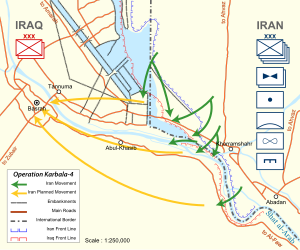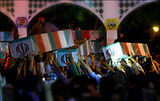Operation Karbala-4
This article includes a list of general references, but it lacks sufficient corresponding inline citations. (August 2014) |
| Operation Karbala-4 | |||||||
|---|---|---|---|---|---|---|---|
| Part of the Iran–Iraq War | |||||||
 | |||||||
| |||||||
| Belligerents | |||||||
|
|
| ||||||
| Commanders and leaders | |||||||
|
|
| ||||||
| Units involved | |||||||
|
3rd Corps 7th Corps |
Najaf Corps Quds Corps Karbala Corps Nouh Corps | ||||||
| Strength | |||||||
| unknown | 60,000 | ||||||
| Casualties and losses | |||||||
| 2,000 |
12,000 4,000 captured | ||||||
Operation Karbala-4 was an Iranian offensive in the Iran-Iraq War on the southern front. The operation was launched after the failure of Operation Karbala-2 and Operation Karbala-3 to move the Iraqi lines in an effort to capture Iraqi territory.
Prelude
The battle itself was planned and eventually executed by Ali Akbar Hashemi Rafsanjani. The operation would be launched under cover of darkness in order to gain a foothold along the Arvand Rūd/Shatt-al-Arab waterway. Once across, the Iranian forces would go on the offensive and eventually move onto the port city of Basra. The attack would be launched towards the Umm ar-Rasas Island in the Shatt al Arab. It most likely was meant as a diversionary attack before the upcoming Operation Karbala-5 (although it may have been called that only after it failed). It would attack from Umm ar-Rasas island to other islands and roads to help create a broad encirclement of Basra. It may have been rushed ahead to intimidate the Islamic Summit Conference meeting in then Iraqi ally Kuwait.
The Iraqis had constructed heavy static fortifications around the city. They built 5 defensive rings, supported by natural waterways such as the Shatt-al-Arab, and manmade ones, such as Fish Lake and the Jasim River, along with manmade earth barriers. Fish Lake was filled with mines, underwater barbed wire, electrodes and various sensors. In addition, behind each waterway and defensive line was radar-guided artillery, ground attack aircraft, and combat helicopters; all capable of firing poison gas in addition to conventional munitions.[12] Iran's strategy was to penetrate through these massive defensive lines, and encircle Basra, cutting off the city as well as the Al-Faw peninsula from the rest of Iraq. While being the largest and most sophisticated attack since 1984, it was actually a part of Iran's strategy of attrition, in order to strike an unsustainable blow against Iraq, as the Iranians had little hope of a decisive victory in the face of Iraq's massive rearmament. There were hopes that it could bring about Iraq's downfall through sheer depletion. [75] Iran's plan was for a diversionary attack near Basra (Karbala-4), the main offensive (Karbala-5), and another diversionary attack using Iranian armor in the north to have Iraqi heavy armor diverted away from Basra (Karbala-6).[12] For these battles, Iran had re-expanded their military by recruiting many new Basij and Pasdaran volunteers.
The battle
The operation began during Christmas night of 1986 with elite frogmen of the Pasdaran crossing the lake in rubber speedboats to launch a surprise attack upon Umm al-Rasas Island. Upon landing, Iraqi searchlight operators found the frogmen. The Iranians were now totally exposed. Iraqi machine gunners opened up with a hail of bullets, killing all but a few of the Iranian force.
The following morning, 60,000 Pasdaran and Basijis crossed the Shatt al-Arab north and south of Khorramshahr in dinghies and motorized seacraft, using the cover of dawn to hide their movements. Almost immediately, the Iranians met the Iraqi defenses waiting for them on the shorelines of the island. A major drawback for the Iranians came in the form of little to no artillery support against the Iraqis. However the Iranians quickly overran Umm al-Rasas and the other islands, and they crossed them using pontoon bridges. But when they tried to move up the road along the waterway to envelop Basra from the south, they came under withering Iraqi fire.
A major inadequacy in Iranian military preparations for the offensive was the practically non-existent follow up support provided to their forces once they broke out from the islands. With the exception of limited artillery support, all of it remained on the Iranian side of the Shatt al-Arab and did not follow with the initial advance of their own forces. Fighting lasted for three days, during which the Iranian forces were pummeled by the Iraqi defenses. Iraqi troops used artillery, aircraft, and machine guns firing from prepared defenses. Iranian troops died by the thousands. Iraqi casualties were one-sixth that of Iranian losses. By the time the Iranians retreated, thousands of dead Iranian soldiers covered the landscape. Iran had lost 12,000 troops, while Iraq had lost 2,000. Iran claimed Iraq's defenses benefited from US supplied intelligence which provided details of Iranian plans and preparations, thus permitting Iraq to coordinate an effective defense as precise points where the attack occurred. Iraqi mistreatment of captured Iranian forces, including the burying alive of military divers became the subject matter for the 2015 Iranian film 175 Divers. [1]
Aftermath
The battle killed 12,000 Iranians and 2,000 Iraqis in those three days alone. However, this battle proved to be the beginning of a major offensive of which would last until February. The operation had been poorly planned, and doubtlessly rushed due to the Kuwait conference. The Iranians (with the exception of the night attack and the amphibious crossings) did not use their innovative tactics and mainly used human waves. The more sophisticated Operation Karbala-5 would be launched two weeks later and would eventually become the largest battle of the whole war.
Returning bodies of 175 Iranian divers
On May 18, 2015, bodies of 175 Iranian divers who were reportedly buried alive with their hands tied returned to Iran.[2][3][4][5] Some of the bodies were discovered with no injuries, and it was realized they were buried alive with their hands tied.[6][7] The fighters belonged to four units from 25th, 41st, 7th and 14th divisions.[8]
The repatriation led to an unprecedentedly emotional response on Iranian social media.[9]
| External image | |
|---|---|
Iran later published a stamp for the 175 divers.[10]
In 2015, Iranian filmmakers started production of a movie about the operation, naming it 175 Divers.[11]
Bibliography
1. Essential Histories: The Iran Iraq War 1980-1988, by Efraim Karsh, Osprey Publishing, 2002
2. In The Name of God: The Khomeini Decade, by Robin Wright, Simon & Schuster, 1989
3. In The Rose Garden Of The Martyrs: A Memoir Of Iran, by Christopher de Bellaigue, HarperCollins, 2005
4. http://csis.org/files/media/csis/pubs/9005lessonsiraniraqii-chap08.pdf
References
- ^ http://presstv.ir/Detail/2015/09/18/429700/Iran-divers-Iraq-war
- ^ "Return of 175 Iranian bodies from Iraq stirs painful memories". Al-Monitor. 2015-05-21. Retrieved 2015-06-12.
- ^ "Return of 175 martyr divers agitates grievous memories in Iran". Organization for Educational Research and Planning. 2015-06-09. Retrieved 2015-06-12.
- ^ https://www.reuters.com/article/us-iran-divers-idUSKBN0OW20Q20150616
- ^ "Remains of Iranian divers killed by Saddam's Iraq (PHOTOS) » Iran Front Page". Iran Front Page. 2015-06-07. Retrieved 2015-06-12.
- ^ "Return of 175 martyr divers agitates grievous memories in Iran". Mehr News Agency. 2015-05-30. Retrieved 2015-06-12.
- ^ "Remains of Iranian divers killed by Saddam's Iraq". The Iran Project. 2015-06-07. Retrieved 2015-06-12.
- ^ http://www.mehrnews.com/news/2769763/%D8%AC%D8%B2%D8%A6%DB%8C%D8%A7%D8%AA-%D8%B4%D9%87%D8%A7%D8%AF%D8%AA-%DB%B1%DB%B7%DB%B5%D8%BA%D9%88%D8%A7%D8%B5-%D8%AE%D8%B7-%D8%B4%DA%A9%D9%86-%D9%85%D8%B8%D9%84%D9%88%D9%85%DB%8C%D8%AA%DB%8C-%DA%A9%D9%87-%D8%AF%D8%B1-%D8%A8%D8%A7%D8%B2%DB%8C-%D8%B1%D8%B3%D8%A7%D9%86%D9%87-%D8%A7%DB%8C-%D8%A8%DB%8C%D8%B4%D8%AA%D8%B1%D8%B4%D8%AF
- ^ "Social Media's Users' Mourning for 175 Martyr Divers with Tied Hands", Etemaad Newspaper, May 23, 2015, http://etemadnewspaper.ir/Default.aspx?News_Id=15802
- ^ http://theiranproject.com/blog/2015/09/28/iran-to-unveil-martyr-divers-stamp/
- ^ http://shahid.ifilmtv.ir/Default/Details/442918
- Atlas of Iran Iraq War, a concise of ground battles. Tehran: The Center for War Studies and Researches. 2007. p. 76. ISBN 964-6315-41-0.



